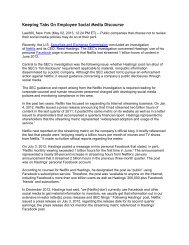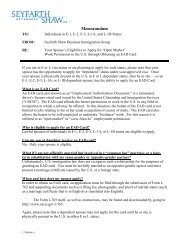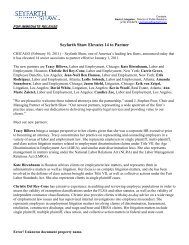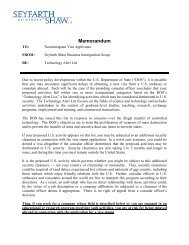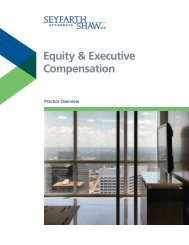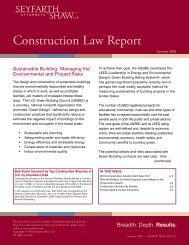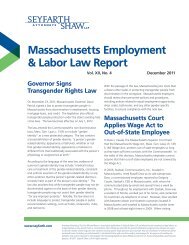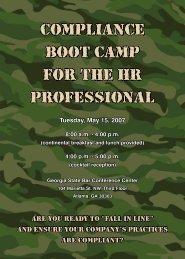Leap of Faith: How much will Six Sigma pay off for Seyfarth Shaw?
Leap of Faith: How much will Six Sigma pay off for Seyfarth Shaw?
Leap of Faith: How much will Six Sigma pay off for Seyfarth Shaw?
You also want an ePaper? Increase the reach of your titles
YUMPU automatically turns print PDFs into web optimized ePapers that Google loves.
www.americanlawyer.com April 2010<br />
This cover did not appear in The American Lawyer. It is a custom cover created <strong>for</strong> the sole distribution <strong>of</strong> <strong>Seyfarth</strong> <strong>Shaw</strong>.
By D.M. Levine<br />
<strong>Leap</strong><br />
Of <strong>Faith</strong><br />
<strong>How</strong> <strong>much</strong> <strong>will</strong> <strong>Six</strong> <strong>Sigma</strong><br />
<strong>pay</strong> <strong>of</strong>f <strong>for</strong> <strong>Seyfarth</strong> <strong>Shaw</strong>?<br />
Partner Lisa Damon spearheads the firm’s<br />
<strong>Six</strong> <strong>Sigma</strong> work. Some 1,500 employees<br />
are expected to be trained by year-end.<br />
It was the height <strong>of</strong> the securities boom in 2006, and <strong>Seyfarth</strong> <strong>Shaw</strong> real estate partner<br />
Andrew Pearlstein was feeling the pressure. His client, Merrill Lynch & Co., Inc., was<br />
awash in mortgage-backed securities, and insisting that the law firms working on these<br />
michel leroy<br />
transactions cut their rates. “We were doing 60–70<br />
real estate finance closings a year,” Pearlstein says.<br />
“Our clients were these financial institutions . . .<br />
and we were getting squeezed tighter and tighter.<br />
[They were demanding,] ‘Can’t you get your fees<br />
down? Can’t you get your fees down?’ ”<br />
At the time, securitization work was plentiful,<br />
but there was stiff competition among law firms.<br />
So <strong>Seyfarth</strong> began looking <strong>for</strong> novel ways to improve<br />
its turnaround time and cut costs on these<br />
deals. J. Stephen Poor, the firm’s managing partner,<br />
and Lisa Damon, national chair <strong>of</strong> <strong>Seyfarth</strong>’s<br />
labor and employment practice, had recently been<br />
talking to each other about <strong>Six</strong> <strong>Sigma</strong>, a method<br />
by which business processes are broken into discrete<br />
tasks and each step is carefully examined.<br />
The methodology had never been <strong>for</strong>mally adopted<br />
at a law firm be<strong>for</strong>e, but some in-house lawyers<br />
had been using it <strong>for</strong> years.<br />
As a real estate and structured finance lawyer,<br />
Pearlstein was an obvious choice <strong>for</strong> a trial<br />
run. Nevertheless, when his colleagues first suggested<br />
that he put the securitization process<br />
through <strong>Six</strong> <strong>Sigma</strong> “mapping,” Pearlstein was<br />
skeptical: “I thought it was going to be an annoyance<br />
in that I knew how to do what I needed<br />
to do.” Firm leaders worked with him to analyze<br />
the lawyering—breaking down each real estate<br />
deal and questioning every stage <strong>of</strong> the closing<br />
process, from when the loan first came across his<br />
desk to when the last bit <strong>of</strong> paperwork was sent<br />
out. “When we began to look at it, we started to<br />
say, ‘Okay, why do we do this at this point? And<br />
why is it that four people do the same thing<br />
here?’ ” says Pearlstein.<br />
<strong>Seyfarth</strong> was able to reduce the number <strong>of</strong><br />
steps involved from the mid-200s to 170. The<br />
firm was also able to bill Merrill (which passed
The core metric <strong>for</strong> judging<br />
<strong>Seyfarth</strong>’s <strong>Six</strong> <strong>Sigma</strong> ef<strong>for</strong>ts,<br />
says managing partner<br />
Stephen Poor, is not ROI,<br />
but “client satisfaction.”<br />
And by the end <strong>of</strong> this year, all <strong>of</strong> the firm’s<br />
more than 1,500 employees <strong>will</strong> be trained<br />
in <strong>Seyfarth</strong>Lean, as its adaptation <strong>of</strong> the <strong>Six</strong><br />
<strong>Sigma</strong> program has come to be known. The<br />
IT staff has built a whole technological infrastructure<br />
around the ideology, and <strong>Seyfarth</strong><br />
has created<br />
three administrative<br />
positions within the<br />
firm to oversee the<br />
process. “The goal is to make [<strong>Six</strong> <strong>Sigma</strong>]<br />
part <strong>of</strong> our DNA,” says Poor.<br />
The <strong>Seyfarth</strong> lawyers argue that they’ve<br />
invested so <strong>much</strong> time, ef<strong>for</strong>t, and money<br />
under <strong>Six</strong> <strong>Sigma</strong><br />
techniques. The<br />
firm hopes to double<br />
the amount <strong>of</strong> revenue <strong>Six</strong> <strong>Sigma</strong> work<br />
brings in every year.<br />
Firm leaders also point to <strong>Six</strong> <strong>Sigma</strong>’s less<br />
tangible rewards to measure its success. One<br />
<strong>of</strong> the core metrics <strong>for</strong> the firm “is the satisfaction<br />
<strong>of</strong> the client,” says Poor. <strong>Six</strong> <strong>Sigma</strong> can<br />
“lead to a better understanding <strong>of</strong> how [clients]<br />
define value in a legal relationship, how<br />
<strong>Six</strong> <strong>Sigma</strong> can "lead to a better understanding<br />
<strong>of</strong> how [clients] define value in a legal relationship,<br />
how to deliver that value, and, <strong>of</strong> course, how to price it."<br />
-Stephen Poor<br />
the legal costs along to its borrowers) 12–15<br />
percent less on these deals. As a result, “the<br />
client became happier . . . and we got the<br />
deals done faster,” Pearlstein says.<br />
For <strong>Seyfarth</strong>, the experience proved to be<br />
a revelation. Over the next few months, Poor<br />
and Damon expanded the <strong>Six</strong> <strong>Sigma</strong> process<br />
into other practice areas, including immigration<br />
and labor and employment. Four<br />
years later, <strong>Seyfarth</strong>’s lawyers have generally<br />
embraced the philosophy. They want to be<br />
known by it, and they’ve staked their image<br />
and reputation on the hope that the method<br />
<strong>will</strong> give them an advantage in a shifting law<br />
firm landscape.<br />
Now every practice area at the firm uses<br />
the <strong>Six</strong> <strong>Sigma</strong> approach to varying degrees.<br />
in <strong>Six</strong> <strong>Sigma</strong> in part because it is the right<br />
strategy <strong>for</strong> these challenging economic<br />
times. Clients have become increasingly<br />
aggressive in their demands <strong>for</strong> savings, and<br />
<strong>Six</strong> <strong>Sigma</strong> is a way <strong>of</strong> trying do legal work as<br />
efficiently as possible.<br />
While it may be the right sales slogan <strong>for</strong><br />
the postrecessionary era, <strong>Six</strong> <strong>Sigma</strong> does have<br />
its limitations. For one thing, it isn’t cheap.<br />
<strong>Seyfarth</strong> has spent over $3 million to date<br />
administering and training workers on the<br />
philosophy, and budgets $200,000–$500,000<br />
annually <strong>for</strong> these costs. Even with that hefty<br />
investment, <strong>Seyfarth</strong> points to just $800,000<br />
to $1 million a year in savings <strong>for</strong> the law firm<br />
from applying <strong>Six</strong> <strong>Sigma</strong> techniques. (<strong>Seyfarth</strong><br />
lawyers say that they hope to increase<br />
those savings by 50 percent in 2010.)<br />
Still, <strong>Seyfarth</strong> estimates that $17 million<br />
<strong>of</strong> work (3.7 percent <strong>of</strong> its $465 million<br />
to deliver that value, and, <strong>of</strong> course, how to<br />
price it.”<br />
Like a prudent business, <strong>Seyfarth</strong> began<br />
to worry about its future in 2005 while the<br />
law firm boom was still expanding. “What<br />
we all saw during that 2002–05 period was<br />
explosive growth in law firm pr<strong>of</strong>its,” Poor<br />
says. “[But we were] trying to anticipate<br />
‘what are the next five years, what are the<br />
next ten years? What does it look like going<br />
<strong>for</strong>ward?’ ”<br />
At the same time, <strong>Seyfarth</strong>—a 65-yearold<br />
Chicago firm with ten <strong>of</strong>fices—was also<br />
trying to differentiate itself from its Am Law<br />
100 peers. Just around the time that pressure<br />
was coming down on partners like Pearlstein<br />
“It’s very easy in most cases to just say, ‘We’ll do all this<br />
discovery. We’ll wait to the end [to do<br />
motion practice]. . . . And that might not always be the most<br />
efficient and best approach <strong>for</strong> a client.”<br />
-Lorie Almon<br />
gross revenue <strong>for</strong> 2008) was completely<br />
done according to <strong>Six</strong> <strong>Sigma</strong>. And another<br />
10–15 percent <strong>of</strong> work was partially done<br />
Inspired by <strong>Six</strong> <strong>Sigma</strong>,<br />
partner Lorie Almon went<br />
looking <strong>for</strong> a cheaper, faster<br />
way to cut a client’s costs.
to cut costs, Poor stumbled upon a book<br />
about <strong>Six</strong> <strong>Sigma</strong>—a business methodology<br />
started at Motorola, Inc., and made famous<br />
in the 1990s by Jack Welch, <strong>for</strong>mer CEO <strong>of</strong><br />
General Electric Company. <strong>Seyfarth</strong> had clients<br />
who’d been using <strong>Six</strong> <strong>Sigma</strong> <strong>for</strong> years,<br />
and Poor and Damon started having conversations<br />
with them. Poor says, “The reaction<br />
we largely got from clients was, ‘It’s about<br />
time. We’ve been doing this <strong>for</strong> a while, and<br />
we’ve never quite understood why the law<br />
firms don’t do this.’ ”<br />
Traditionally, law firms measure productivity<br />
by how many hours an attorney can<br />
bill—the more hours, the more “productive”<br />
that person is. <strong>Six</strong> <strong>Sigma</strong> upends that idea.<br />
“[<strong>Six</strong> <strong>Sigma</strong>] is contrary to the basic precept<br />
<strong>of</strong> law firms,” says Wes Blumenshine, associate<br />
general counsel at Caterpillar Inc. “Most<br />
lawyers want to make use <strong>of</strong> their time and<br />
bill their clients. And they’re compensated<br />
on the basis <strong>of</strong> billable hours and not on<br />
the basis <strong>of</strong> reducing costs.” Blumenshine<br />
was one <strong>of</strong> the in-house lawyers <strong>Seyfarth</strong> attorneys<br />
consulted about <strong>Six</strong> <strong>Sigma</strong> in 2006;<br />
the manufacturing giant has been using the<br />
method <strong>for</strong> years. At the time <strong>Seyfarth</strong> was,<br />
and still is, Caterpillar’s national employment<br />
counsel, doing employee-related counseling<br />
and litigation <strong>for</strong> the company. Blumenshine<br />
says that he can’t estimate the net savings<br />
<strong>Seyfarth</strong> has achieved <strong>for</strong> Caterpillar through<br />
the firm’s use <strong>of</strong> <strong>Six</strong> <strong>Sigma</strong>, because the body<br />
<strong>of</strong> work varies so widely from year to year.<br />
But “presumptively they do things better<br />
than they used to, and that results in fewer<br />
hours billed and lower cost to us,” Blumenshine<br />
says.<br />
He says that finding these efficiencies can<br />
“endear you to that client, and then the client<br />
<strong>will</strong> use you <strong>for</strong> that work and other work.”<br />
But, Blumenshine adds, “there is some leap<br />
<strong>of</strong> faith there.”<br />
That leap also applied to <strong>Seyfarth</strong>’s partners.<br />
When the firm’s leaders started preaching<br />
the gospel <strong>of</strong> <strong>Six</strong> <strong>Sigma</strong>, “We had partners<br />
say, ‘Are you out <strong>of</strong> your mind? You can’t<br />
do it this way. This is magic. There’s an art to<br />
this,’ ” says Poor. He acknowledges that there<br />
remains resistance at the firm among lawyers<br />
who don’t want to change their ways.<br />
<strong>Seyfarth</strong> was able to adapt <strong>Six</strong> <strong>Sigma</strong> to<br />
<strong>much</strong> <strong>of</strong> its work because <strong>of</strong> the nature <strong>of</strong> its<br />
core practice areas—real estate finance, immigration,<br />
and labor and employment—involve<br />
somewhat repetitive legal tasks. “If you<br />
look at legal work and law firms as a pyramid,<br />
at the very top are firms [that engage in<br />
complex, big deals]. . . . They get $1,000 an<br />
hour to do that work. And <strong>Seyfarth</strong> is not one<br />
<strong>of</strong> those firms,” says Arthur Don, a partner<br />
who left the firm last September <strong>for</strong> Greenberg<br />
Traurig. “And then you go down a line<br />
where you need really skilled people who<br />
have a good knowledge <strong>of</strong> the law . . . [and]<br />
a good enough quantity or repetition <strong>of</strong> work<br />
to justify [something like <strong>Six</strong> <strong>Sigma</strong>]. As early<br />
adopters, <strong>Seyfarth</strong> was adroitly selecting areas<br />
where, because <strong>of</strong> billing pressures and<br />
because <strong>of</strong> the volume <strong>of</strong> work and repetitive<br />
tasks, <strong>Six</strong> <strong>Sigma</strong> worked <strong>for</strong> them.”<br />
Lorie Almon, co–managing partner <strong>of</strong> the<br />
firm’s New York <strong>of</strong>fice, says using <strong>Six</strong> <strong>Sigma</strong><br />
paid <strong>of</strong>f <strong>for</strong> a wage-and-hour case she settled<br />
<strong>for</strong> a large service company last year. The suit<br />
was a collective action brought by employees<br />
alleging that the company wrongly exempted<br />
them from overtime. Almon teamed up with<br />
a litigation project manager—an internal<br />
<strong>Seyfarth</strong> administrator trained in <strong>Six</strong> <strong>Sigma</strong>.<br />
She and the project manager process mapped<br />
parts <strong>of</strong> the case looking <strong>for</strong> strategic advantages.<br />
One area <strong>of</strong> leverage was segmenting<br />
discovery, attacking it in blocks. Almon decided<br />
to try to persuade opposing counsel to<br />
limit discovery and go into motion practice as<br />
soon as possible. They agreed, and her team<br />
conducted full discovery on just a third <strong>of</strong> the<br />
more than 4,000 plaintiffs. The reduced discovery<br />
helped cut the costs <strong>for</strong> <strong>Seyfarth</strong>’s client<br />
“by about a third,” says Al mon. Ultimately,<br />
she adds, the case was settled favorably <strong>for</strong><br />
her client on the basis <strong>of</strong> what was uncovered<br />
in the streamlined discovery process: “It’s<br />
very easy in most cases to just say, ‘We’ll do<br />
all this discovery. We’ll wait to the end [to do<br />
motion practice]. . . . And that might not always<br />
be the most efficient and best approach<br />
<strong>for</strong> a client.”<br />
Word has spread <strong>of</strong> <strong>Six</strong> <strong>Sigma</strong>’s benefits<br />
to potential new clients. David Allgood, general<br />
counsel <strong>of</strong> Royal Bank <strong>of</strong> Canada, is not<br />
a <strong>Seyfarth</strong> client yet, but he has sent the firm<br />
a request <strong>for</strong> proposal <strong>for</strong> business litigation<br />
<strong>for</strong> the bank. He’s seriously considering hiring<br />
<strong>Seyfarth</strong>, in large part, he says, because<br />
<strong>of</strong> the efficiencies they’ve promised. “I’m not<br />
expecting that [<strong>Seyfarth</strong>] is going to cut my<br />
bills in half,” says Allgood, “I want to explore<br />
it more, because I think there’s some potential<br />
significant savings in getting this stuff<br />
done.”<br />
<strong>Seyfarth</strong>’s use <strong>of</strong> the technique has also<br />
brought lost business back to the firm. “We<br />
used <strong>Seyfarth</strong> a decade ago <strong>for</strong> some litigation<br />
and moved away from them because they<br />
were not efficient,” says Jeffrey Carr, general<br />
counsel <strong>of</strong> FMC Technologies, Inc. Recently<br />
FMC put <strong>Seyfarth</strong> on its preferred provider<br />
list <strong>for</strong> litigation counsel. “The reason we<br />
chose <strong>Seyfarth</strong> was because <strong>of</strong> its <strong>Six</strong> <strong>Sigma</strong><br />
approach,” Carr explains.<br />
Client testimonials are all well and good.<br />
The key questions moving <strong>for</strong>ward, though,<br />
are whether <strong>Seyfarth</strong>’s <strong>Six</strong> <strong>Sigma</strong>–induced<br />
savings <strong>will</strong> be bigger than they are now, and<br />
ultimately, whether the firm’s rebranding as<br />
<strong>Seyfarth</strong>Lean <strong>will</strong> prove worth the ef<strong>for</strong>t two<br />
or three years down the line.<br />
Poor admits that this is a topic <strong>of</strong> concern.<br />
“We tend to get very excited [at <strong>Seyfarth</strong>],<br />
and we talk in terms <strong>of</strong> absolutes, and<br />
we talk in terms <strong>of</strong> ‘this is great,’ ” says Poor.<br />
“There’s nothing absolute about any <strong>of</strong> this.<br />
The last thing I want to do is overstate where<br />
we are, or that this is a perfect solution.” But<br />
<strong>for</strong> <strong>Seyfarth</strong>’s <strong>Six</strong> <strong>Sigma</strong> clients, efficiency<br />
may trump perfection.<br />
E-mail: dmlevine@alm.com.<br />
Reprinted with permission from the April 2010 edition <strong>of</strong> THE AMERICAN LAWYER© 2009 ALM Media Properties, LLC. All rights reserved. Further duplication without permission is<br />
prohibited. For in<strong>for</strong>mation, contact 877-257-3382 or reprints@alm.com. # 001-03-10-13<br />
www.seyfarth.com



